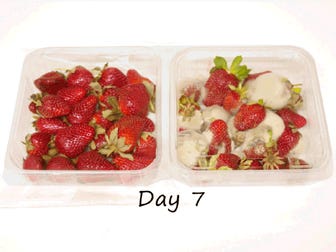Blown- and cast-film extrusion line manufacturer Colines (with manufacturing sites in Novara and Varese, Italy) says recent testing proves that PLA/PVOH films extruded on the company’s cast- and blown-film lines with structures of up to 7 layers and with thicknesses from 50 to 90 µm offer sufficient oxygen barrier properties, while also maintaining top optic performance, as shown by the values of haze and gloss and the film’s printability.
July 17, 2009
Blown- and cast-film extrusion line manufacturer Colines (with manufacturing sites in Novara and Varese, Italy) says recent testing proves that PLA/PVOH films extruded on the company’s cast- and blown-film lines with structures of up to 7 layers and with thicknesses from 50 to 90 µm offer sufficient oxygen barrier properties, while also maintaining top optic performance, as shown by the values of haze and gloss and the film’s printability.
|
Colines officials say the lines have been modified so as to render the same performance as lines running barrier films containing polyamide or ethylene vinyl alcohol (EVOH) barrier materials, with no loss in line productivity.
The combined structure of polylactic acid (PLA), based on plant starches, and polyvinyl alcohol (PVOH, a biodegradable, water soluble polymer) in these barrier films offers sufficient gas barrier performance to prove them suitable for use for applications such as packaging of meat and fish, but in particular, fruit and vegetables.
The company is inviting interested processors to its open house from July 27-31, 2009, and requests email pre-registration at [email protected]. Also during that open house the company plans to run a line extruding breathable film with an in-line double mono-orienting unit (MDO). The line, which can extrude breathable film in PE and in PP, has a useful width 2200 mm and the double-MDO unit offers orientation of up to 600% (2 x 300%). It will feature post-stretching embossing and comes outfitted with a thickness control before and after the stretching, with automatic adjustment according to the set target. Trim is recovered directly and pelletized.
It also includes the firm’s Fast AdJUST (Elav) system for micrometric adjustments of the stretching parameters of the line. Colines reports it has worked with this system and is able to offer processors the option of live monitoring of the data relative to the extrusion lines. The report system lets a user track consumption data (energy and raw material), various trends (throughout and machine data), recipes, management of the production orders, ordinary and preventive maintenance, and diagnostics. The acquisition and processing of the data is incorporated directly in the automation system, with the data then able to be sent to computers on the other side of a facility or even further afield. —[email protected]
About the Author(s)
You May Also Like



